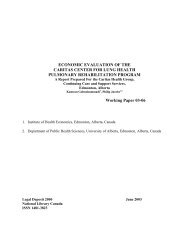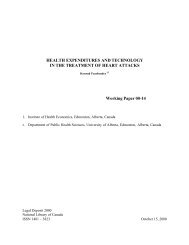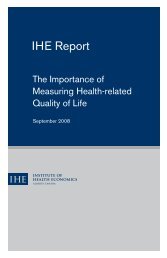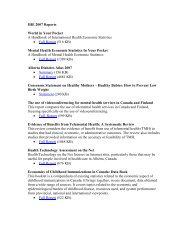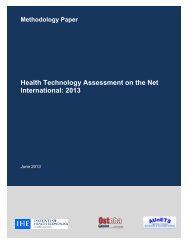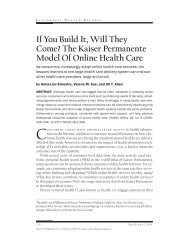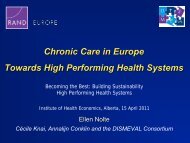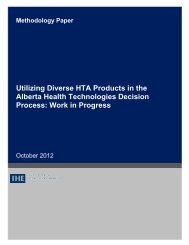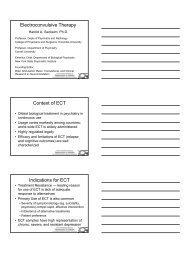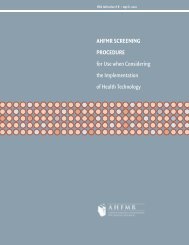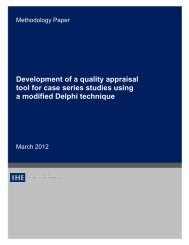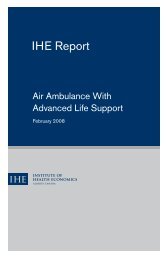Bariatric treatments for adult obesity - Institute of Health Economics
Bariatric treatments for adult obesity - Institute of Health Economics
Bariatric treatments for adult obesity - Institute of Health Economics
- No tags were found...
Create successful ePaper yourself
Turn your PDF publications into a flip-book with our unique Google optimized e-Paper software.
Weight management program (WMP) versus no intervention or usual careGustafson et al. 25 assessed the cost-effectiveness <strong>of</strong> a 16-week weight loss program <strong>for</strong> low-incomewomen in the US in comparison with no intervention, using clinical and resource use data collectedfrom an RCT. The study adopted a payers’ perspective and was conducted over lifetime. Studypopulation comprised women between 40 and 60 years <strong>of</strong> age with a BMI between 25 kg/m 2 and 45kg/m 2 and an income ≤ 200% <strong>of</strong> the federal poverty level, 46% <strong>of</strong> whom had high blood pressure,29% <strong>of</strong> whom had high cholesterol, and 67% <strong>of</strong> whom were obese. The weight-wise interventionconsisted <strong>of</strong> weekly counselling sessions during a 16-week period, with a focus on consuming nineor more fruit and vegetable servings daily and lifestyle change through self-monitoring, problemsolving,and goal-setting. Cost categories were the costs <strong>of</strong> staff time, program materials, rental spaceand utilities/overhead. Results indicated that the WMP was associated with $1947 per life year saved,as compared to no intervention. The study concluded that the weight-wise intervention was a costeffectiveoption.Gusi et al. 26 used data from an RCT to assess the cost-effectiveness <strong>of</strong> a walking program in Spainover a 6-month period, compared to best care. The study population comprised women 60 years orolder with a BMI between 25 kg/m 2 and 39.9 kg/m 2 or 6 to 9 points in the 15-item GeriatricDepression Scale. The cost analysis was conducted from a payer’s perspective and considered healthsystem costs, including personnel time, facilities, medications and consultation. The walkingprogram consisted <strong>of</strong> walks with a group in public park or <strong>for</strong>est tracks, guided by the qualifiedexercise leaders, <strong>for</strong> 50 minutes, three times per week over 6 months. Individuals in best carereceived routine care with a recommendation to increase physical activity. Results indicated that theprogram was associated with a cost <strong>of</strong> $419 per QALY gained, as compared to best care. The studyconcluded that the walking program was cost-effective <strong>for</strong> depressed or overweight elderly women.Bemelmans et al. 27 conducted a Markov model to evaluate the clinical and economic impact <strong>of</strong> acommunity-based intervention and an intensive LM to reduce overweight prevalence, as comparedto no intervention. The community-based intervention <strong>of</strong>fered social support such as self-helpgroups, risk factor screening and/or counselling to 90% <strong>of</strong> general population, and the intensive LMwas <strong>of</strong>fered to 10% <strong>of</strong> the population and targeted at overweight individuals. The study adopted apayer’s perspective and was conducted over an 80-year horizon. Cost categories were the costs <strong>of</strong>the interventions and treatment <strong>for</strong> <strong>obesity</strong>-related morbidity. Results indicated that, compared to nointervention, the cost was $6878 per LY gained and $6743 per QALY gained <strong>for</strong> the communitybasedintervention, $11,328 per LY gained and $9980 per QALY gained <strong>for</strong> the intensive LM, and$8092 per LY gained and $7687 per QALY gained <strong>for</strong> the combination <strong>of</strong> both programs. The studyconcluded that both community-based intervention and intensive lifestyle modification were costeffective<strong>for</strong> preventing and reducing overweight, and that the <strong>for</strong>mer was slightly more costeffective.Lifestyle modification (LM) versus other LM or no interventionBesides the studies (described above) that evaluated LM versus other bariatric services, fourstudies 28-31 compared LM versus other LM or no treatment.Olsen et al. 28 used data from an RCT enrolling 401 patients to assess the cost-effectiveness <strong>of</strong>nutritional counselling by a GP or a dietician <strong>for</strong> patients with a BMI ≥ 30 kg/m 2 and with a highrisk <strong>for</strong> ischaemic heart disease (IHD), as compared to no counselling. The counselling by GPsconsisted <strong>of</strong> general advice plus written in<strong>for</strong>mation on health and diet, and the counselling bydieticians focused on principles <strong>of</strong> good nutrition and advice about food shopping, cooking<strong>Bariatric</strong> <strong>treatments</strong> <strong>for</strong> <strong>adult</strong> <strong>obesity</strong> 168



